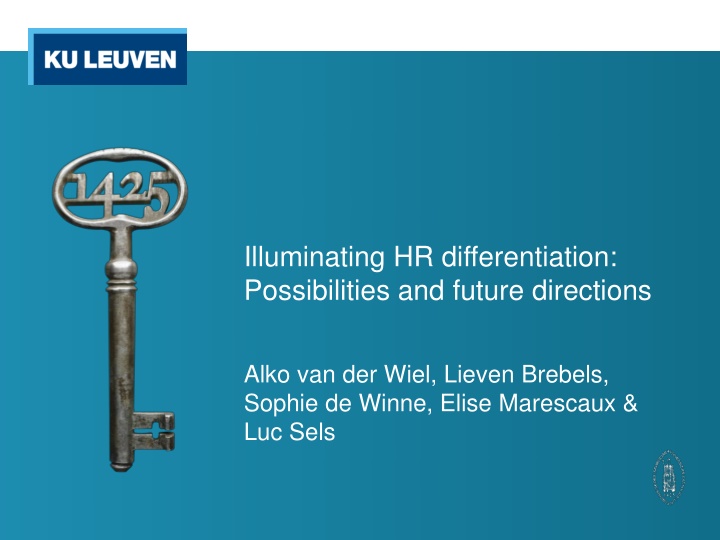
Exploring HR Differentiation: Possibilities and Future Directions
Delve into the realm of HR differentiation with a focus on the distribution of outcomes among employees. This theoretical concept, backed by limited empirical evidence, sheds light on varying aspects of perceived differentiation within teams. Consider job content, flexible working arrangements, financial compensation, and developmental opportunities as key areas of exploration.
Download Presentation

Please find below an Image/Link to download the presentation.
The content on the website is provided AS IS for your information and personal use only. It may not be sold, licensed, or shared on other websites without obtaining consent from the author. If you encounter any issues during the download, it is possible that the publisher has removed the file from their server.
You are allowed to download the files provided on this website for personal or commercial use, subject to the condition that they are used lawfully. All files are the property of their respective owners.
The content on the website is provided AS IS for your information and personal use only. It may not be sold, licensed, or shared on other websites without obtaining consent from the author.
E N D
Presentation Transcript
Illuminating HR differentiation: Possibilities and future directions Alko van der Wiel, Lieven Brebels, Sophie de Winne, Elise Marescaux & Luc Sels
Introduction HR differentiation: the differential distribution of outcomes among employees. Largely theoretical (Lepak & Snell, 2002; Collings et al., 2017; Rousseau, 2005) Limited empirical evidence (Marescaux et al., 2013a,b) o o
Introduction HR differentiation: the differential distribution of outcomes among employees. Largely theoretical (Lepak & Snell, 2002; Collings et al., 2017; Rousseau, 2005) Limited empirical evidence (Marescaux et al., 2013a,b) o o Illuminating the HR differentiation story: Consider different types of outcomes Job content Flexible working arrangements Financial compensation Developmental opportunities
Introduction HR differentiation: the differential distribution of outcomes among employees. Largely theoretical (Lepak & Snell, 2002; Collings et al., 2017; Rousseau, 2005) Limited empirical evidence (Marescaux et al., 2013a,b) o o Illuminating the HR differentiation story: Consider different aspects of perceived differentiation Existing differences within the team Within-group comparisons Strength-matched differentiation
Introduction HR differentiation: the differential distribution of outcomes among employees. Largely theoretical (Lepak & Snell, 2002; Collings et al., 2017; Rousseau, 2005) Limited empirical evidence (Marescaux et al., 2013a,b) o o Illuminating the HR differentiation story: Consider different aspects of perceived differentiation Within my team, there are [small large] differences in responsibility. Within-group comparisons Strength-matched differentiation
Introduction HR differentiation: the differential distribution of outcomes among employees. Largely theoretical (Lepak & Snell, 2002; Collings et al., 2017; Rousseau, 2005) Limited empirical evidence (Marescaux et al., 2013a,b) o o Illuminating the HR differentiation story: Consider different aspects of perceived differentiation Within my team, there are [small large] differences in responsibility. Compared to my team members, I receive [less more] extralegal bonuses. Strength-matched differentiation
Introduction HR differentiation: the differential distribution of outcomes among employees. Largely theoretical (Lepak & Snell, 2002; Collings et al., 2017; Rousseau, 2005) Limited empirical evidence (Marescaux et al., 2013a,b) o o Illuminating the HR differentiation story: Consider different aspects of perceived differentiation Within my team, there are [small large] differences in responsibility. Compared to my team members, I receive [less more] extralegal bonuses. Training opportunities enable team members to further develop their strengths.
Method Two-wave cross-lagged survey ~ 250 participants Second measurement: ~ month later Dutch-speaking, full-time contracts Minimum 1 year tenure
Method Measurements besides perceived HR differentiation: Usual suspects: - Affective organizational commitment - Turnover intentions - Extrarol behavior Interesting opportunities: - Social identity - Leadership -
Results Factor analysis Factor 1 Factor 2 Factor 3 Factor 4 Task Differentiation 0,741 Task Differentiation 0,786 Task Differentiation 0,713 Flexibility Differentiation 0,745 Flexibility Differentiation 0,810 Flexibility Differentiation 0,716 Financial Differentiation Financial Differentiation 0,570 Financial Differentiation 0,628 Developmental Differentiation 0,752 Developmental Differentiation 0,813 Developmental Differentiation 0,682
Results Factor analysis Factor 1 Factor 5 Factor 6 Task Differentiation 0,741 Task Differentiation 0,786 Task Differentiation 0,713 Task Comparisons 0,697 Task Comparisons 0,714 Task Comparisons 0,786 Task Strengths 0,677 Task Strengths 0,679 Task Strengths 0,694
Results Factor analysis Factor 3 Financial Differentiation Financial Differentiation 0,570 Financial Differentiation 0,628 Financial Comparisons Financial Comparisons 0,658 Financial Comparisons 0,701 Financial Strengths Financial Strengths 0,690 Financial Strengths 0,820
Results Consistency and correlations Cronbach AOC Extrarol Turnover Task differentiation 0,831 -0,02 0,10 0,08 0,15 Flex. Differentiation 0,861 0,14 0,04 0,02 Finan. Differentiation 0,793 -0,08 0,20 0,14 Dev. Differentiation 0,853 0,03 0,06 Task. comparison 0,830 0,07 0,36 0,02 Flex. Comparison 0,826 0,15 0,18 0,03 Finan. Comparison 0,734 0,13 0,15 0,05 Dev. Comparison 0,811 0,21 0,19 0,05 Task. Strength-matched 0,798 0,19 0,11 -0,12 Finan. Strength-matched 0,815 0,24 0,07 0,00 Dev. Strength-matched 0,859 0,15 0,08 -0,05
Extending empirical evidence: replication Within-group comparisons Financial Within-group comparisons Flexibility AOC Within-group comparisons Developmental Marescaux et al. (2013)
Extending empirical evidence: extension Within-group comparisons Financial Extrarol behavior Within-group comparisons Flexibility AOC Within-group comparisons Developmental Turnover Within-group comparisons Job content Social identity
Extending empirical evidence: results = 0,019 Within-group comparisons Financial Extrarol behavior = -0,089 Within-group comparisons Flexibility = 0,369*** AOC = -0,149 Within-group comparisons Developmental = -0,426*** Turnover = 0,049 CFI = 0,86 TLI = 0,848 RMSEA = 0,058 SRMR = 0,064 Within-group comparisons Job content Social identity
Extending empirical evidence: results = 0,019 Within-group comparisons Financial Extrarol behavior = -0,089 Within-group comparisons Flexibility = 0,369*** AOC = -0,149 Within-group comparisons Developmental = -0,426*** Turnover = 0,049 Beta-term int. with financial = 0,302** Beta-term int. with flexibility = 0,206* Beta-term int. with developmental = -0,316** Beta-term int. with task = -0,154* Within-group comparisons Job content Social identity
Extending empirical evidence: results Social identity Social identity Social identity Social identity Job content Developmental Financial Flexibility
Conclusion Exploratory factor analysis of the data revealed reliable subdivisions of HR differentiation. HR differentiation matters! Relationships are dependent upon the type of outcome considered. These relationships seem susceptible to possible moderators, such as social identification. Less can be more.
Thank you for your attention! Any questions or suggestions?






















